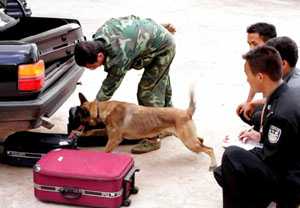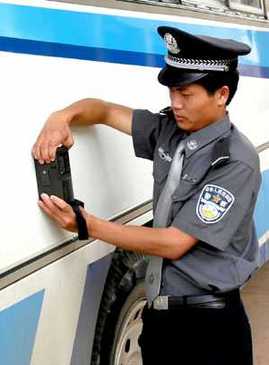"Drug control is a long running battle," says a slogan painted on a wall in Jiele Village, in an area of southwest China popular with tourists. Nearby, armed volunteers of a local militia that assists the police in fighting drug trafficking are patrolling in camouflage gear.
Jiele is on the border with Myanmar, adjacent to the notorious Golden Triangle, one of Asia's main opium producing areas.
Wang Han, the village's Party secretary recalled how in the early 1980s, increasing number of local residents began to use opium and drug-use exacerbated poverty in the community. In 1989 China's first case of intravenously transmitted AIDS was discovered in the village.
"Drugs destroy families. I have seen at least ten couples divorce because of drug use," he said with a heavy heart.
Other villages bordering Myanmar have been suffering from the same problem.
When Professor Xiang Chunling studied Xia Po in 2005 there had been no weddings in a decade. Deaths from drugs-related illnesses had turned the village into a ghost town and the inhabitants had lost all hope for the future.
 |
|
A sniffer dog is trained to find drugs in Kunming, Yunnan Province. |
The Chinese government responded to the growing drugs problem by strengthening the law and setting up specialist anti-drug squads. In 1982 serious drug trafficking was made a capital offence. In the same year, a 1000-strong anti-narcotics force, the first of its kind in China, was formed in Yunnan Province.
Chasing drug traffickers is a dangerous business. In Yunnan alone, 40 narcotics cops have been killed and more than 200 wounded since 1982. Policemen's families are also in danger. Yang Yu, former director of the Dehong Public Security Bureau, said traffickers had offered money to kill not just him but also his wife and children.
Narcotics keep evolving, and in the 1990s new types such as methamphetamine and MDMA aka Ecstasy began to arrive in China over its northwestern, southeastern and northeastern borders.
In 1990, the National Narcotics Control Commission (NNCC), was set up to supervise the nationwide anti-drug campaign and promote international cooperation. The NNCC convened a conference on drug problems attended by China, Thailand, Myanmar and the UN. China pledged aid to Laos and Myanmar to fund crop substitution programs to discourage poppy cultivation. The Ministry of Public Security claims that poppy acreage in Myanmar's northern regions has fallen 85 percent since 1995.
When heroin was the drug of choice in the 1980s, drug trafficking and money laundering were the major law enforcement issues. But China, at that time, was just a relay post.
During the mid-1990s, China, however, became a major producer of methamphetamine partly because its main ingredient, ephedrine, is used in Chinese medicine. A major production and trafficking network set up by Liu Zhaohua, the manufacturer, and Chen Bingxi, a drug lord who controlled the trafficking network, produced over 18 tons of methamphetamine in underground factories in Guangdong and Ningxia. Liu, an extremely intelligent former chemist, also partnered with Tan Xiaolin, a top drug lord from the Golden Triangle. It took the Myanmar, Vietnamese and Chinese police six years to crack their syndicate.
China also became an important consumer of narcotics in the 1990s. The numbers taking drugs grow each year. According to the authorities there are now nearly a million drug users in China.
 |
|
A policeman?detects a bus suspected to be loaded with drugs with?a Gamma-ray apparatus.?? |
In 1998, the Ministry of Public Security set up the Narcotics Control Bureau. Simultaneously the China Narcotics Control Foundation was set up to carry out drugs-related social programs. In 2005 China passed a law requiring local governments to include anti-narcotics campaigns into their overall plans for social and economic development.
All these efforts are making a difference. Between 1982 and 2005, Yunnan arrested 195,000 traffickers and seized 129 tons of illicit drugs. The number of addicts in the province has fallen to 50,000. Yang Fengrui, director of the Ministry of Public Security's Narcotics Control Bureau, said that nationwide the rate of growth in the number of drug users has slowed from 30 percent annually in 1995, to below 5 percent in 2008.
Meanwhile a detoxification program has revitalized Jiele. Wang Han, the Party secretary, has nothing but praise for the team of specialists that started work in the village in 2005. Methadone substitution therapy has allowed villagers formerly addicted to heroin to live productive lives. Annual per capita income has grown from a few hundred yuan up to over 3,000 yuan (about US$439) and the village has regained its former beauty and tranquility.
(China.org.cn by Pang Li,?November 1, 2008)